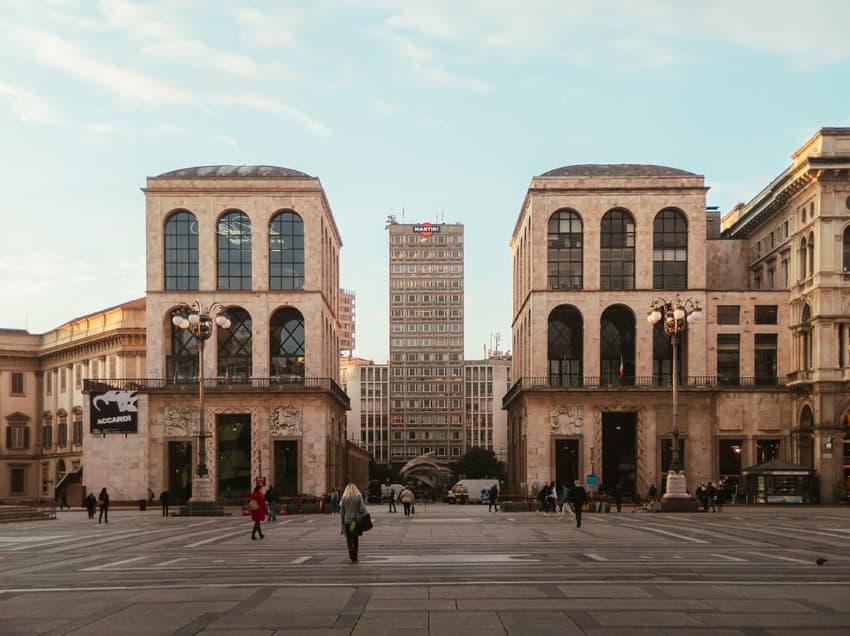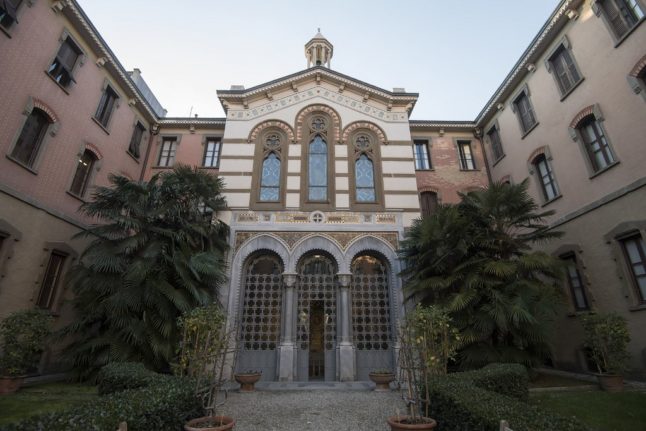Five of the best ‘hidden’ sites to visit in Milan this weekend

Italy’s usually inaccessible cultural sites will open their doors to the public this weekend as part of a National Trust initiative. Here are five unmissable places to visit in Milan if you’re in town.
The popular Giornate FAI – nationwide open days held twice a year by Italy’s National Trust (Fondo Ambiente Italiano, FAI) – will be back on this weekend, with a wealth of usually inaccessible historical sites opening their doors to the public on March 25th and 26th.
From private villas and gardens to castles, abbeys and libraries, all of Italy’s major art cities – Venice, Verona, Rome, Florence, Bologna and so on – will give residents and international visitors a unique chance to see some of their lesser-known heritage sites free of charge or, in some cases, via small donations (generally around three euros).
And, while it might not share the artistic cachet of some of the above-mentioned cities, Milan will also have plenty to offer for the occasion as some of its ‘hidden’ artistic gems will be open to all for 48 hours.
So, from monumental city buildings to private mansions, here are the best five places to visit in the northern capital this weekend.
Palazzo Marino
Lying just a short walk away from the Duomo and facing the iconic Piazza della Scala, Palazzo Marino is one of the best examples of Mannerist art and architecture in the country.
READ ALSO: Metro, bus or tram: How to use Milan’s public transport
Built between 1557 and 1563 at the behest of wealthy local banker Tommaso Marino, the palace has been the seat of Milan’s town hall since 1861.
Palazzo Marino#cortile#architettura pic.twitter.com/PnuSbVsbrz
— Vana Bojaxhiu 🇪🇺 (@vanabeau) May 25, 2016
But, despite their current administrative functions, Palazzo Marino’s rooms are still home to invaluable sculptures and paintings from Italian art masters, including Giambattista Tiepolo.
The palace also boasts one of the best courtyards in the city.
Palazzo Arcivescovile
Sitting right behind the Duomo and facing Piazza Fontana, Palazzo Arcivescovile has been the seat of Milan’s archdiocese since the early 14th century.
READ ALSO: Seven things to do in Milan on a rainy day
All of the palace’s spaces will be open to the public over the weekend, from the majestic staircase that survived World War II bombings to the Curia’s courtyard and the first-floor chapel with its Renaissance-inspired fresco paintings.
Casa di Riposo per Musicisti
The Casa di Riposo per Musicisti (literally ‘Care Home for Retired Musicians’) was built in the late 19th century at the behest of Italian composer Giuseppe Verdi, who intended it as a shelter for “elderly singers who have not been favoured by fortune”.

A crypt (above) within Milan's Casa di Riposo per Musicisti holds the remains of Italian composer Giuseppe Verdi. Photo by Miguel MEDINA / AFP
The building, which faces Piazza Buonarroti in western Milan, is one of the best Italian examples of neo-Gothic architecture and among the best works of architect Camillo Boito.
The Casa di Riposo also displays a number of personal items and manuscripts which belonged to Verdi himself.
Ippodromo di San Siro
The San Siro area is mostly known for the iconic Meazza Stadium, which is home to local football teams AC Milan and Inter Milan.
READ ALSO: What are the best Milan neighbourhoods for international residents?
But the city’s hippodrome is also located in the neighbourhood.

The entrance of Milan's San Siro Hippodrome features a large-scale bronze horse by artist Nina Akamu. Photo by Damien MEYER / AFP
Built in the early 20th century, the venue is known for its exquisite Liberty architecture and for the verdant gardens surrounding the racing tracks.
Jockeys’ changing rooms and the saddling area will be accessible to the public over the weekend.
Istituto dei Ciechi
The Istituto dei Ciechi (literally ‘Institute of the Blind’) is an Eclectic-style building located in the Porta Monforte area, just north-east of the city centre.
Built as a school for blind people in the late 19th century, the institute has undergone various changes over the decades but has retained most of its original artworks, which include fresco paintings from Ferdinando Brambilla and Celso Stocchetti.
La visita guidata all'istituto dei Ciechi di #Milano sarà un'occasione per visitare un'istituzione storica di Milano generalmente chiusa al pubblico, ma ricca di arte e di storia. https://t.co/dANO6nRure pic.twitter.com/TYjT0UnApT
— SPEND IN Milano (@SPENDINmilano) January 18, 2019
The building has also been home to the Louis Braille Museum since 2009 and its Salone Barozzi, which boasts one of the first Italian-made pipe organs, is regularly chosen as the venue for prestigious international concerts.
For further info about the above sites and bookings, visit FAI's (Fondo Ambiente Italiano) website.
Comments (1)
See Also
The popular Giornate FAI – nationwide open days held twice a year by Italy’s National Trust (Fondo Ambiente Italiano, FAI) – will be back on this weekend, with a wealth of usually inaccessible historical sites opening their doors to the public on March 25th and 26th.
From private villas and gardens to castles, abbeys and libraries, all of Italy’s major art cities – Venice, Verona, Rome, Florence, Bologna and so on – will give residents and international visitors a unique chance to see some of their lesser-known heritage sites free of charge or, in some cases, via small donations (generally around three euros).
And, while it might not share the artistic cachet of some of the above-mentioned cities, Milan will also have plenty to offer for the occasion as some of its ‘hidden’ artistic gems will be open to all for 48 hours.
So, from monumental city buildings to private mansions, here are the best five places to visit in the northern capital this weekend.
Palazzo Marino
Lying just a short walk away from the Duomo and facing the iconic Piazza della Scala, Palazzo Marino is one of the best examples of Mannerist art and architecture in the country.
READ ALSO: Metro, bus or tram: How to use Milan’s public transport
Built between 1557 and 1563 at the behest of wealthy local banker Tommaso Marino, the palace has been the seat of Milan’s town hall since 1861.
Palazzo Marino#cortile#architettura pic.twitter.com/PnuSbVsbrz
— Vana Bojaxhiu 🇪🇺 (@vanabeau) May 25, 2016
But, despite their current administrative functions, Palazzo Marino’s rooms are still home to invaluable sculptures and paintings from Italian art masters, including Giambattista Tiepolo.
The palace also boasts one of the best courtyards in the city.
Palazzo Arcivescovile
Sitting right behind the Duomo and facing Piazza Fontana, Palazzo Arcivescovile has been the seat of Milan’s archdiocese since the early 14th century.
READ ALSO: Seven things to do in Milan on a rainy day
All of the palace’s spaces will be open to the public over the weekend, from the majestic staircase that survived World War II bombings to the Curia’s courtyard and the first-floor chapel with its Renaissance-inspired fresco paintings.
Casa di Riposo per Musicisti
The Casa di Riposo per Musicisti (literally ‘Care Home for Retired Musicians’) was built in the late 19th century at the behest of Italian composer Giuseppe Verdi, who intended it as a shelter for “elderly singers who have not been favoured by fortune”.

The building, which faces Piazza Buonarroti in western Milan, is one of the best Italian examples of neo-Gothic architecture and among the best works of architect Camillo Boito.
The Casa di Riposo also displays a number of personal items and manuscripts which belonged to Verdi himself.
Ippodromo di San Siro
The San Siro area is mostly known for the iconic Meazza Stadium, which is home to local football teams AC Milan and Inter Milan.
READ ALSO: What are the best Milan neighbourhoods for international residents?
But the city’s hippodrome is also located in the neighbourhood.

Built in the early 20th century, the venue is known for its exquisite Liberty architecture and for the verdant gardens surrounding the racing tracks.
Jockeys’ changing rooms and the saddling area will be accessible to the public over the weekend.
Istituto dei Ciechi
The Istituto dei Ciechi (literally ‘Institute of the Blind’) is an Eclectic-style building located in the Porta Monforte area, just north-east of the city centre.
Built as a school for blind people in the late 19th century, the institute has undergone various changes over the decades but has retained most of its original artworks, which include fresco paintings from Ferdinando Brambilla and Celso Stocchetti.
La visita guidata all'istituto dei Ciechi di #Milano sarà un'occasione per visitare un'istituzione storica di Milano generalmente chiusa al pubblico, ma ricca di arte e di storia. https://t.co/dANO6nRure pic.twitter.com/TYjT0UnApT
— SPEND IN Milano (@SPENDINmilano) January 18, 2019
The building has also been home to the Louis Braille Museum since 2009 and its Salone Barozzi, which boasts one of the first Italian-made pipe organs, is regularly chosen as the venue for prestigious international concerts.
For further info about the above sites and bookings, visit FAI's (Fondo Ambiente Italiano) website.
Join the conversation in our comments section below. Share your own views and experience and if you have a question or suggestion for our journalists then email us at [email protected].
Please keep comments civil, constructive and on topic – and make sure to read our terms of use before getting involved.
Please log in here to leave a comment.